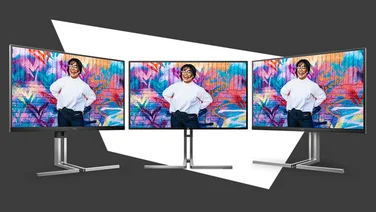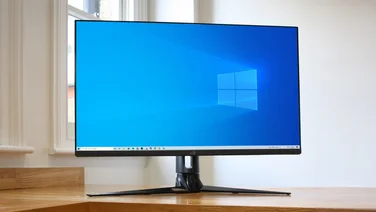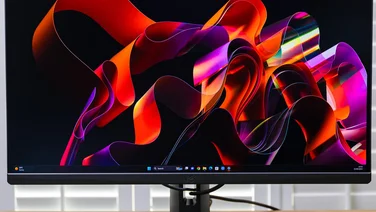To help us provide you with free impartial advice, we may earn a commission if you buy through links on our site. Learn more








- 144Hz refresh rate at 1440p
- Low input lag
- Stunningly vibrant
- HDR on Windows 10 isn’t plug and play
- Brightness reduced in faster response time modes
It doesn’t matter whether you’re one of the world’s fastest athletes or just one of the many millions of gamers across the globe, the difference between winning and losing routinely comes down to fractions of a second. Regardless of whether it’s the right pair of shoes, or the perfect monitor, the right tools can turn a runner-up into a winner. This time around, however, Samsung’s latest gaming monitor has more than just split-second reaction times on its mind: in addition to a claimed response time of just one millisecond, the C27HG70 is also the world’s first HDR gaming monitor.
Samsung C27HG70 review: Price and competition
Scanning through the Samsung C27HG70’s specifications is like reading through a gamer’s monitor-buying wishlist. This is a 27in, 144Hz gaming monitor with HDR, a 1800R curved panel, AMD FreeSync 2 technology (which is also backwards compatible with FreeSync 1), and the VA quantum-dot panel promises more than just quick response times – it’s also capable of displaying a wider range of colour than standard VA panels.
READ NEXT: Best gaming monitors
At £600 in the UK ($600 in the US), the Samsung C27HG70 certainly isn’t a cheap gaming monitor. It’s also worth mentioning that the 32in variant of the monitor costs only £50 more at the time of writing ($650 in the US).
As the only HDR gaming monitor currently available, the Samsung has little in the way of direct competitors. There are plenty of excellent non-curved, non-HDR 144Hz displays out there, though. If £600 is beyond your means, then you can take your pick of the Acer XF270HUA at around £480 with an IPS panel, the AOC AGON AG271QX at around £410 with a TN panel, and the ASUS ROG PG279Q at around £690 with an IPS panel and Nvidia G-Sync.
Samsung C27HG70 review: Design, features and build quality
PC monitors rarely set the pulse racing, but the C27HG70 is keen to buck the trend. Tiny bezels surround the 1800R curved panel, and the wide, almost claw-like stand holds the monitor with the same double-jointed arm design seen on last year’s Samsung C24FG70. This isn’t just fancy-looking for the sake of it: it provides full height, tilt, pivot and swivel adjustments for getting the monitor in millimetre-perfect position. In the unlikely scenario that it doesn’t provide enough adjustability, you can mount the C27HG70 to any compatible VESA 100 x 100mm stand.








Connectivity hits the spot nicely, too. There’s a single DisplayPort 1.4 input alongside two HDMI 2 ports; a 3.5mm audio output jack; and the two USB 3 ports are capable of delivering up to 1.5A per port when the fast charging mode is enabled through the monitor’s onscreen display (OSD). And while we’re on the subject, the Samsung’s OSD is supremely easy to use: the joystick found on the bottom-right-hand corner of the monitor makes it quick and easy to dive in and change settings, and the clear, straightforward menu system does its bit too.
One of the more unusual features of Samsung’s gaming monitors is the addition of “Arena Lighting” – something we’ve seen on previous models such as the C24FG70. A strip of LED lights provides a gentle blue glow behind the monitor, similar to the bias lighting technique employed by Philips’ Ambilight TVs. This isn’t just a gimmick, though: bias lighting is proven to reduce the eye strain caused by viewing a display in darker lighting conditions, and can also improve the perceived depth of blacks and darker greys. The only issue in Samsung’s implementation here is the decision to move the LED array from its usual position on the underside of the monitor to the rear: I had to unscrew the rear circular plastic mould to get enough light to come through to boost the very gentle bias lighting effect, as it was barely noticeable otherwise.
Samsung C27HG70 review: Image quality
The Samsung C27HG70’s 2,560 x 1,440 VA panel uses quantum dot technology to reproduce a wider range of colour. In our tests, the panel is capable of reproducing 99.5% of the sRGB colour gamut, and it also covers a respectable 88% of the DCI P3 gamut. As you’d hope, colour accuracy is a high point too – a measured average Delta E of 1.75 is an excellent result for a non-professional monitor. If you want a gaming monitor that can also turn its hand to photo or video editing, the C27HG70 won’t be out of its depth.








A maximum brightness of 400cd/m2 in the monitor’s Standard response time mode will prove bright enough for pretty much any lighting conditions, but this figure drops substantially when the other response time settings are used. Set the C27HG70 to either of the “Fast” or “Fastest” modes and the maximum brightness dips down to 250cd/m2. This, to me, is too dull to be used in a brightly lit room – a limitation I identified in last year’s C24FG70 – so you’ll need to dim the lights to take full advantage of the monitor’s fastest modes. Thankfully, though, there are no complaints about the quality of the backlighting, and the Samsung passed our brightness-uniformity tests with flying colours.
High contrast ratios are par for the course with VA panel technology, but nevertheless the C27HG60 acquits itself well with both SDR and HDR sources. With an SDR source, the combination of high brightness and a 0.16cd/m2 black level produced a high 2,524:1 contrast ratio. I borrowed Samsung’s Klein K10-A Colorimeter to conduct tests on an HDR test pattern, and the C27HG70 delivered a peak brightness of 667cd/m2 with a 13,340:1 dynamic contrast ratio (0.05cd/m2 black level).
Samsung C27HG70 review: Gaming performance
You’d expect a 144Hz monitor with a quoted 1ms response time (that’s measured using the MPRT standard, in case you’re wondering) to keep up with the very fastest gaming action, and the C27HG70 doesn’t disappoint. Enabling the “Fast” or “Fastest” response-time settings and the “Low Input Lag” mode provide an almost-perfect recipe for competitive gaming. After hours of gaming on the C27HG70, I was consistently impressed by the monitor’s ability to control unwanted visual artefacts – there’s only the tiniest hint of purple fringing visible at the fastest response times.








I say almost perfect, as these faster response time settings do have one other unwanted side effect: as I mentioned previously, the maximum brightness is limited to 250cd/m2. If the lowest response time is an absolute priority, there’s only one solution: turn down those lights.
It’s great to see AMD FreeSync support back on the feature list, and the C27HG70 now supports AMD FreeSync 2, with a quoted 48-144Hz FreeSync range. Hook up a Radeon RX series card with the latest Polaris architecture, and you can enjoy crystal-clear, tear-free HDR gaming at the highest frame rates. Nvidia users can still take advantage of the monitor’s 144Hz refresh rate, but sadly are limited to using standard V-Sync – which of course adds unwanted lag.








Samsung C27HG70 review: HDR performance
High dynamic range (HDR) is the key selling point here, and this is the first time that the technology has made its way from Samsung’s TVs to its range of gaming monitors.
A display’s ability to produce a high maximum brightness is the key to great HDR performance, but unlike TVs – which routinely achieve a peak brightness of above 1,000cd/m2 – the C27HG70 achieves a more modest 600cd/m2. However, this isn’t as disappointing as it sounds – given how close you sit to a monitor compared a TV, that should be enough to provide pleasingly intense highlight detail without permanently searing your retinas.
Using the C27HG70 with HDR-enabled consoles such as the Xbox One S couldn’t be easier. Simply plug in the HDMI cable, pop a 4K HDR Blu-ray in the drive, and you’re good to go. The console detects the monitor as an HDR-enabled panel, and passes all of Microsoft’s checks in the Xbox settings menu. If you’re looking to playback HDR content through a Blu-ray player or a compatible console, the Samsung C27HG70 will be able to display the content without any hitches – albeit not at its native 4K resolution.
HDR and Windows 10 don’t play quite so nicely together, however. First, you’ll need to make sure you’ve got a compatible graphics card. Samsung lists the AMD RX480, RX470 and RX460, and Nvidia Titan X, GTX 1080 Ti, GTX 1080, GTX 1070, GTX 1060, and GTX 1050 as compatible cards. Naturally, AMD’s newest RX5xx series will also work as it’s based on the same architecture as last year’s RX4xx series.








If your home PC contains a graphics card that isn’t listed, such as an MSI GeForce GTX 960, HDR support is a little more hit and miss. In the case of my GTX 960, HDR works via an HDMI connection, but not DisplayPort – and you’ll encounter similar problems with any graphics cards that don’t support the DisplayPort 1.4 standard required for HDR compatibility. Upgrade to one of the supported cards, however – I tried Sapphire’s RX580 8GB card – and you can use either connection type.
The first time you enable HDR through the Windows display settings, you might wonder if something’s gone horribly wrong. As the Windows desktop, and most apps for that matter, don’t support HDR natively, you’ll be presented with a dim, washed-out image. Don’t panic, though: it’s not until you fire up an HDR-enabled game that you’ll notice the benefits.
Currently, only a handful of titles actually support HDR. At the time of writing, you can take your pick from the seven games listed below.
• Shadow Warrior 2
• Deus Ex: Mankind Divided
• Hitman (2016)
• Resident Evil 7
• Mass Effect: Andromeda
• Obduction
• Paragon
Shadow Warrior 2 provided a perfect demonstration of the benefits of HDR. Colours become more lifelike thanks to the more natural transition from dark shadows to intensely bright highlights, and reflections or sunlight glinting off objects such as swords or guns suddenly look far more realistic. Look up to the sky and you’ll see an intensely bright sun alongside the clear outline of delicate, wispy clouds – the kind of detail that becomes bleached out almost entirely in SDR mode.
HDR still isn’t a plug-and-play experience on PC, however. In Shadow Warrior 2, I had to reduce the in-game gamma level from 1 to 0.8 to stop images looking washed out – you’ll need to spend a little time experimenting with different games’ settings to achieve the best visuals.
Samsung C27HG70 review: Verdict
Despite the HDR niggles, the Samsung C27HG70 is a superb gaming monitor. Class-leading colour accuracy, response time and input lag would be enough to win many gamer’s hearts, but those traits combined with the Samsung’s other talents – the gorgeous design, HDR and curved panel – go a long way towards making the price look reasonable. Given that the larger 32in model only costs £50 more, that makes the CHG70 look like even better value.
Be in no doubt, though, that you’re paying a premium for HDR. And while the C27HG70 works perfectly with the current crop of HDR-enabled consoles, Windows 10’s implementation is still a long way from the plug-and-play experience delivered by its console cousins. Clearly, this isn’t Samsung’s fault but, as ever, being an early adopter has its downsides.
If you’re happy to spend time tweaking in-game settings to get HDR just so, however – and you don’t mind paying a premium for top-notch performance – then there’s no question about it: the Samsung C27HG70 delivers the kind of visual fireworks that no other monitor can.









